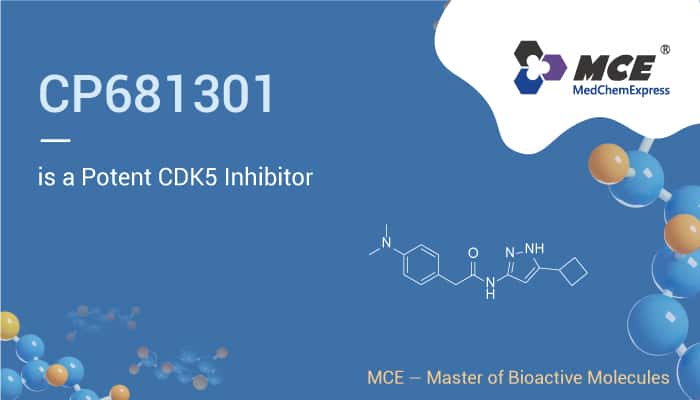CDKs (Cyclin-dependent kinases) are serine-threonine kinases first discovered for their role in regulating the cell cycle. They are also involved in regulating transcription, mRNA processing, and the differentiation of nerve cells.
CDK5 is one of the Cyclin-dependent kinases. Importantly, CDK5 is an unconventional Cdk that regulates developmental and adult neurogenesis, as well as cell survival in post-mitotic neurons. Particularly, it is saliently expressed in post-mitotic central nervous system neurons (CNS). Moreover, CDK5 plays a critical role in the growth and propagation of multiple forms of cancer. We also show that antagonizing this CDK5-CREB1 pathway suppresses both self-renewal of GSCs and glioma growth. Here, we will introduce small-molecule tyrosine kinase inhibitors for cancer treatment.
CP681301 is a potent CDK5 inhibitor for cancer.

CP681301 (0-1000 nM) inhibits the kinase catalytic activity of CDK5-p35 and CDK5-p25 in a dose-dependent manner. Specifically, CP681301 completely abolishes the activities of both CDK5-P35 and CDK5-P25 at a concentration of 1 μM. Besides, this compound (1 μM; 96 h) shows variably cytotoxic to the tested GSC (Glioma stem cells) cultures but was not toxic to NHNPs (normal human neural progenitor cells). Additionally, CP681301 (0, 10, 50 µM; 48 h) decreases the expression of CD133, OLIG2, SOX2, KI67, pCDK5 protein level in GSCs. Moreover, CP681301 (0, 0.5, 1 µM) suppresses the expression of CREB Ser133 phosphorylation. CP681301 also reduces the self-renewal properties of GSCs.
CP681301 reduces cell proliferation in xenograft tumors but not normal brain tissue. Specifically, CP681301 (0, 10, 50 µM; 48 h) reduces the phosphorylation of CDK5 as well as the expression of the proliferation marker Ki67 in GBM121 and GBM39 GSCs in vitro. Meanwhile, CP681301 (1 mM; fed; 10 days) shows anti-tumor activity in 0- to 2-day-old adult Drosophila.
All in all, CP681301 is a potent CDK5 inhibitor and shows anti-tumor activity.
Reference:
[1] Mukherjee S, et al. Cell Rep. 2018 May 8;23(6):1651-1664.